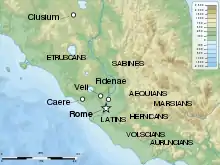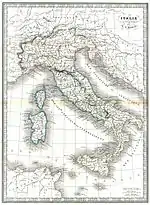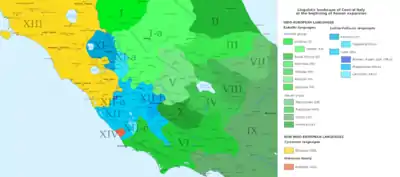Sabines
The Sabines (/ˈseɪbaɪnz/; Latin: Sabini; Italian: Sabini, all exonyms) were an Italic people who lived in the central Apennine Mountains of the ancient Italian Peninsula, also inhabiting Latium north of the Anio before the founding of Rome.
| Sabine | |
|---|---|
 Statue of Semo Sancus from his shrine on the Quirinal | |
| Native to | Sabinum |
| Region | Central Italy |
| Extinct | Only traces of vocabulary, mainly from Marcus Terentius Varro, 1st century BC |
Indo-European
| |
| Not written except as Latinized words | |
| Language codes | |
| ISO 639-3 | sbv |
Linguist List | sbv |
| Glottolog | sabi1245 |
 Map showing the location of the Sabines. The border with Latium to the south was the Aniene river; however, it is possible that Sabines extended to Lake Regillus slightly to the south of it near Gabii. | |
| History of Italy |
|---|
 |
|
Timeline |
The Sabines divided into two populations just after the founding of Rome, which is described by Roman legend. The division, however it came about, is not legendary. The population closer to Rome transplanted itself to the new city and united with the preexisting citizenry, beginning a new heritage that descended from the Sabines but was also Latinized. The second population remained a mountain tribal state, coming finally to war against Rome for its independence along with all the other Italic tribes. Afterwards, it became assimilated into the Roman Republic.
Language
There is little record of the Sabine language; however, there are some glosses by ancient commentators, and one or two inscriptions have been tentatively identified as Sabine. There are also personal names in use on Latin inscriptions from the Sabine country, but these are given in Latin form. Robert Seymour Conway, in his Italic Dialects, gives approximately 100 words which vary from being well-attested as Sabine to being possibly of Sabine origin. In addition to these he cites place names derived from the Sabine, sometimes giving attempts at reconstructions of the Sabine form.[1] Based on all the evidence, the Linguist List tentatively classifies Sabine as a member of the Umbrian group of Italic languages of the Indo-European family.
Historical geography
Latin-speakers called the Sabines' original territory, straddling the modern regions of Lazio, Umbria, and Abruzzo, Sabinum. To this day, it bears the ancient tribe's name in the Italian form of Sabina. Within the modern region of Lazio (or Latium), Sabina constitutes a sub-region, situated north-east of Rome, around Rieti.
Origins

The origins of the Sabines cannot be determined with full certainty, but they are believed to have been in the region of current Lazio since prehistoric times and, once Roman Republic was established, they assimilated into the culture and became citizens of Rome.[2][3]
Literary evidence
Dionysius of Halicarnassus regarded Lista as the mother-city of the Aborigines.[4] Ancient historians debated the specific origins of the Sabines. Zenodotus of Troezen claimed that the Sabines were originally Umbrians that changed their name after being driven from the Reatine territory by the Pelasgians. However, Porcius Cato argued that the Sabines were a populace named after Sabus, the son of Sancus (a divinity of the area sometimes called Jupiter Fidius).[5] In another account mentioned in Dionysius's work, a group of Lacedaemonians fled Sparta since they regarded the laws of Lycurgus as too severe. In Italy, they founded the Spartan colony of Foronia (near the Pomentine plains) and some from that colony settled among the Sabines. According to the account, the Sabine habits of belligerence (aggressive or warlike behavior) and frugality (prudence in avoiding waste) were known to have derived from the Spartans.[6] Plutarch also mentions, in the Life of Numa Pompilius, "Sabines, who declare themselves to be a colony of the Lacedaemonians". Plutarch also wrote that the Pythagoras of Sparta, who was Olympic victor in the foot-race, helped Numa arrange the government of the city and many Spartan customs introduced by him to the Numa and the people.[7]
At Rome
Legend of the Sabine women

Legend says that the Romans abducted Sabine women to populate the newly built Rome. The resultant war ended only by the women throwing themselves and their children between the armies of their fathers and their husbands. The Rape of the Sabine Women became a common motif in art; the women ending the war is a less frequent but still reappearing motif.
According to Livy, after the conflict, the Sabine and Roman states merged, and the Sabine king Titus Tatius jointly ruled Rome with Romulus until Tatius' death five years later. Three new centuries of Equites were introduced at Rome, including one named Tatienses, after the Sabine king.
A variation of the story is recounted in the pseudepigraphal Sefer haYashar (see Jasher 17:1–15).
Traditions
Tradition suggests that the population of the early Roman kingdom was the result of a union of Sabines and others. Some of the gentes of the Roman republic were proud of their Sabine heritage, such as the Claudia gens, assuming Sabinus as a cognomen or agnomen. Some specifically Sabine deities and cults were known at Rome: Semo Sancus and Quirinus, and at least one area of the town, the Quirinale, where the temples to those latter deities were located, had once been a Sabine centre. The extravagant claims of Varro and Cicero that augury, divination by dreams and the worship of Minerva and Mars originated with the Sabines are disputable, as they were general Italic and Latin customs, as well as Etruscan, even though they were espoused by Numa Pompilius, second king of Rome and a Sabine.[8]
Religion
- Dius Fidius
- Feronia
- Ops
- Quirinus
- Sabus
- Sancus
- Soranus
- Vacuna
- Varro's list of Sabine gods
- Flora
State
During the expansion of ancient Rome, there were a series of conflicts with the Sabines. Manius Curius Dentatus conquered the Sabines in 290 BC. The citizenship without the right of suffrage was given to the Sabines in the same year.[9] The right of suffrage was granted to the Sabines in 268 BC.[10]
Prominent Sabines
Gentes of Sabine origin
- Aemilia gens – Patrician
- Aurelia gens
- Calpurnia gens
- Calvisia gens
- Claudia gens – Patrician
- Curtia gens – Patrician
- Flavia gens
- Ligaria (gens)
- Marcia gens – Patrician
- Minatia (gens)
- Oppia gens – Patrician
- Opsia gens
- Ostoria gens
- Pantuleia (gens)
- Petronia gens
- Pinaria gens
- Pompilia gens
- Pomponia gens
- Poppaea gens
- Quirinia gens
- Rania gens
- Rubellia gens
- Sabinia gens
- Safinia gens
- Sallustia gens
- Saturia gens
- Sertoria gens
- Sicinia gens
- Tarpeia gens – Patrician
- Tineia gens
- Titia gens
- Valeria gens – Patrician
Romans of Sabine ancestry
- Titus Tatius, legendary King of the Sabines
- Numa Pompilius, legendary King of Rome
- Ancus Marcius, legendary King of Rome
- Quintus Sertorius, republican general
- Attius Clausus, founder of the Roman Claudia gens
- Gaius Sallustius Crispus, Roman writer
- Marcus Terentius Varro, Roman scholar
- Vespasian, Roman emperor and founder of the Flavian dynasty
See also
| Library resources about Sabines |
- Ancient peoples of Italy
- Hostus Hostilius
References
- Conway, Robert Seymour (1897). The Italic Dialects Edited with a Grammar and Glossary. Cambridge: University Press. pp. 351–369.
- "I Sabini e l'agricoltura: origine, storia, leggende, pastorizia, coltivazioni". Un Mondo Ecosostenibile (in Italian). 2021-02-20. Retrieved 2021-12-10.
- Riposati, Benedetto (1985). Convegno di studio: Preistoria, storia e civiltà dei Sabini (in Italian). Centro di studi varroniani.
- Dionysius of Halicarnassus. "Book I.14". Roman Antiquities.
Twenty-four stades from the afore-mentioned city stood Lista, the mother-city of the Aborigines, which at a still earlier time the Sabines had captured by a surprise attack, having set out against it from Amiternum by night.
- Dionysius of Halicarnassus. "Book II.49". Roman Antiquities.
But Zenodotus of Troezen, a...historian, relates that the Umbrians, a native race, first dwelt in the Reatine territory, as it is called, and that, being driven from there by the Pelasgians, they came into the country which they now inhabit and changing their name with their place of habitation, from Umbrians were called Sabines. But Porcius Cato says that the Sabine race received its name from Sabus, the son of Sancus, a divinity of that country, and that this Sancus was by some called Jupiter Fidius.
- Dionysius of Halicarnassus. "Book II.49". Roman Antiquities.
There is also another account given of the Sabines in the native histories, to the effect that a colony of Lacedaemonians settled among them at the time when Lycurgus, being guardian to his nephew Eunomus, gave his laws to Sparta. For the story goes that some of the Spartans, disliking the severity of his laws and separating from the rest, quit the city entirely, and after being borne through a vast stretch of sea, made a vow to the gods to settle in the first land they should reach; for a longing came upon them for any land whatsoever. At last they made that part of Italy which lies near the Pomentine plains and they called the place where they first landed Foronia, in memory of their being borne through the sea, and built a temple to the goddess Foronia, to whom they had addressed their vows; this goddess, by the alteration of one letter, they now call Feronia. And some of them, setting out from thence, settled among the Sabines. It is for this reason, they say, that many of the habits of the Sabines are Spartan, particularly their fondness for war and their frugality and a severity in all the actions of their lives. But this is enough about the Sabine race.
- Plutarch. "1". Numa.
Pythagoras, the Spartan, who was Olympic victor in the foot-race for the sixteenth Olympiad (in the third year of which Numa was made king), and that in his wanderings about Italy he made the acquaintance of Numa, and helped him arrange the government of the city, whence it came about that many Spartan customs were mingled with the Roman, as Pythagoras taught them to Numa. And at all events, Numa was of Sabine descent, and the Sabines will have it that they were colonists from Lacedaemon. Chronology, however, is hard to fix, and especially that which is based upon the names of victors in the Olympic games, the list of which is said to have been published at a late period by Hippias of Elis, who had no fully authoritative basis for his work. I shall therefore begin at a convenient point, and relate the noteworthy facts which I have found in the life of Numa.
- Bunbury, Edward Herbert (1857). "Sabini". In Smith, William (ed.). Dictionary of Greek and Roman geography. Vol. II Iabadius—Zymethus. Boston: Little, Brown and Company.
- Velleius Paterculus 1.14.6
- Velleius Paterculus 1.14.7
Sources
Ancient
Modern
- Donaldson, John William (1860). "Chapter IV: The Sabello-Oscan Language". Varronianus: a critical and historical introduction to the ethnography of ancient Italy and the philological study of the Latin language. London: John W. Parker and Son.
Further reading
- Brown, Robert. "Livy's Sabine Women and the Ideal of Concordia." Transactions of the American Philological Association 125 (1995): 291-319. doi:10.2307/284357.
- MacLachlan, Bonnie. Women In Ancient Rome: A Sourcebook. London: Bloomsbury Academic, 2013.
